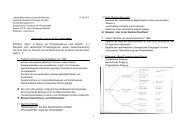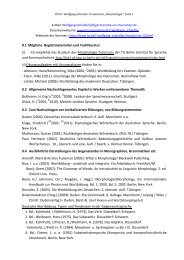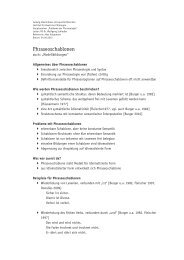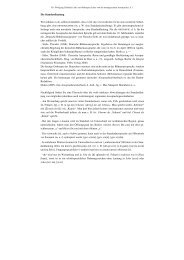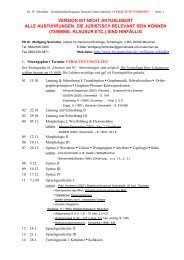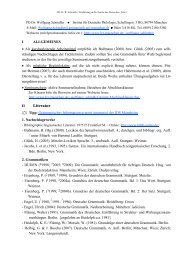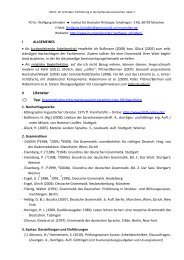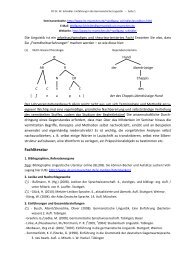Chapter 18 Lexical Functions: Description of Lexical Relations in a ...
Chapter 18 Lexical Functions: Description of Lexical Relations in a ...
Chapter 18 Lexical Functions: Description of Lexical Relations in a ...
Create successful ePaper yourself
Turn your PDF publications into a flip-book with our unique Google optimized e-Paper software.
—<strong>Chapter</strong> <strong>18</strong>. <strong>Lexical</strong> <strong>Functions</strong>— 65<br />
Obstr 2(speech) = //[NY] stutters, stammers, Obstr(saliva) = //[NY’s] mouth is dry, [NY’s]<br />
mumbles tongue sticks to the ro<strong>of</strong> <strong>of</strong> [NY’s] mouth<br />
Obstr(negotiations) = are stalled Obstr(economy) = stagnates<br />
62. Stop [Lat. *stuppāre (stop up, plug)] = cessative<br />
Stop is a verb mean<strong>in</strong>g (stop function<strong>in</strong>g).<br />
Examples<br />
Stop 2(breath) = [NY] loses [NY’s ~] Stop(voice) = breaks<br />
Stop(heart1) = stops Stop(heart2) = breaks<br />
63. Excess [Lat. *excessus] = excessive<br />
Excess is a verb mean<strong>in</strong>g (function <strong>in</strong> an excessive way).<br />
Examples<br />
Excess 2 (heart1) = [NX] has palpitations Excess(eng<strong>in</strong>e) = races<br />
Excess(sweat) = rolls down across [NX’s] Excess motor<br />
2<br />
forehead, trickles down the back <strong>of</strong><br />
(teeth) = [NX] gr<strong>in</strong>ds [NX’s ~]<br />
[NX’s] head, pours <strong>of</strong>f [NX’s] brow Excess motor<br />
2 (sweat) = [NX] is bathed [<strong>in</strong> ~]<br />
[For the superscript motor , see below, 5.1.3.]<br />
64. Sympt [Lat. *symptoma] = symptom<br />
L´ = Sympt(L) is a verbal expression mean<strong>in</strong>g (symptom <strong>of</strong>); more precisely, Sympt denotes<br />
a bodily reaction that is a symptom <strong>of</strong> an emotional or physical state L. Sympt takes three<br />
DSyntAs, the actantial subscripts be<strong>in</strong>g distributed as follows:<br />
itself;<br />
—the subscript ‘ 1’ corresponds to the body part <strong>in</strong> which the symptom <strong>in</strong> question manifests<br />
—the subscript ‘ 2’ corresponds to the person who ‘owns’ the body part <strong>in</strong>volved and who is<br />
the Experiencer <strong>of</strong> the emotion or physical state L;<br />
—and the subscript ‘ 3’, to the emotional or physical state L.<br />
In accordance with our technique <strong>of</strong> express<strong>in</strong>g syntactic conversion (= the permutation <strong>of</strong><br />
DSynt-Actants), the order <strong>of</strong> actantial subscripts specifies the SSynt-role <strong>of</strong> the actants: the sub-<br />
script placed as first corresponds to the SSynt-Subject <strong>of</strong> the verbal expression which is the value<br />
<strong>of</strong> Sympt; the second subscript corresponds to its Ma<strong>in</strong> Object; and the last subscript, to its<br />
Secondary Object. The LF Sympt is used, as a general rule, together with Obstr, Stop and<br />
Excess (as well as with some non-standard LFs), form<strong>in</strong>g with one <strong>of</strong> them the configurations <strong>of</strong><br />
the form F—Sympt, where Sympt specifies that state (L) whose symptoms <strong>in</strong>terest us, and the LF


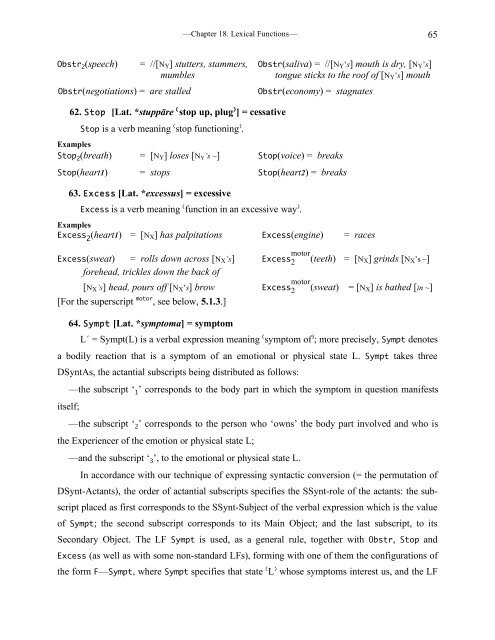
![E-Mail: Wolfgang.Schindler[ätt]germanistik.uni-muenchen.de Web ...](https://img.yumpu.com/51590147/1/184x260/e-mail-wolfgangschindlerattgermanistikuni-muenchende-web-.jpg?quality=85)
